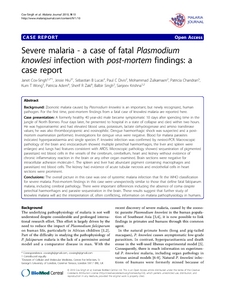Cox-Singh, J;
Hiu, J;
Lucas, SB;
Divis, PC;
Zulkarnaen, M;
Chandran, P;
Wong, KT;
Adem, P;
Zaki, SR;
Singh, B;
et al.
Cox-Singh, J; Hiu, J; Lucas, SB; Divis, PC; Zulkarnaen, M; Chandran, P; Wong, KT; Adem, P; Zaki, SR; Singh, B; Krishna, S
(2010)
Severe malaria - a case of fatal Plasmodium knowlesi infection with post-mortem findings: a case report.
MALARIA JOURNAL, 9 (10).
ISSN 1475-2875
https://doi.org/10.1186/1475-2875-9-10
SGUL Authors: Cox-Singh, Janet Krishna, Sanjeev
![[img]](https://openaccess.sgul.ac.uk/1005/1.hassmallThumbnailVersion/1475-2875-9-10.pdf)  Preview |
|
["document_typename_application/pdf; charset=binary" not defined]
Published Version
Download (500kB)
| Preview
|
Abstract
BACKGROUND: Zoonotic malaria caused by Plasmodium knowlesi is an important, but newly recognized, human pathogen. For the first time, post-mortem findings from a fatal case of knowlesi malaria are reported here.
CASE PRESENTATION: A formerly healthy 40 year-old male became symptomatic 10 days after spending time in the jungle of North Borneo. Four days later, he presented to hospital in a state of collapse and died within two hours. He was hyponatraemic and had elevated blood urea, potassium, lactate dehydrogenase and amino transferase values; he was also thrombocytopenic and eosinophilic. Dengue haemorrhagic shock was suspected and a post-mortem examination performed. Investigations for dengue virus were negative. Blood for malaria parasites indicated hyperparasitaemia and single species P. knowlesi infection was confirmed by nested-PCR. Macroscopic pathology of the brain and endocardium showed multiple petechial haemorrhages, the liver and spleen were enlarged and lungs had features consistent with ARDS. Microscopic pathology showed sequestration of pigmented parasitized red blood cells in the vessels of the cerebrum, cerebellum, heart and kidney without evidence of chronic inflammatory reaction in the brain or any other organ examined. Brain sections were negative for intracellular adhesion molecule-1. The spleen and liver had abundant pigment containing macrophages and parasitized red blood cells. The kidney had evidence of acute tubular necrosis and endothelial cells in heart sections were prominent.
CONCLUSIONS: The overall picture in this case was one of systemic malaria infection that fit the WHO classification for severe malaria. Post-mortem findings in this case were unexpectedly similar to those that define fatal falciparum malaria, including cerebral pathology. There were important differences including the absence of coma despite petechial haemorrhages and parasite sequestration in the brain. These results suggest that further study of knowlesi malaria will aid the interpretation of, often conflicting, information on malaria pathophysiology in humans.
| Item Type: |
Article
|
| Additional Information: |
© 2010 Cox-Singh et al; licensee BioMed Central Ltd. This is an Open Access article distributed under the terms of the Creative Commons Attribution License (http://creativecommons.org/licenses/by/2.0), which permits unrestricted use, distribution, and reproduction in any medium, provided the original work is properly cited. |
| Keywords: |
Adult, Animals, Blood, Borneo, Brain, Endocardium, Fatal Outcome, Humans, Kidney, Liver, Lung, Malaria, Male, Plasmodium knowlesi, Polymerase Chain Reaction, Spleen, Science & Technology, Life Sciences & Biomedicine, Parasitology, Tropical Medicine, FALCIPARUM-MALARIA, CEREBRAL MALARIA, ADHESION MOLECULE-1, ANTIGENIC VARIATION, AFRICAN CHILDREN, VIVAX MALARIA, VAR GENES, PATHOGENESIS, HEMOZOIN, FEATURES |
| SGUL Research Institute / Research Centre: |
Academic Structure > Infection and Immunity Research Institute (INII) |
| Journal or Publication Title: |
MALARIA JOURNAL |
| ISSN: |
1475-2875 |
| Related URLs: |
|
| Dates: |
| Date | Event |
|---|
| 11 January 2010 | Published |
|
| Web of Science ID: |
WOS:000274379500001 |
  |
Download EPMC Full text (PDF)
|
 |
Download EPMC Full text (HTML)
|
| URI: |
https://openaccess.sgul.ac.uk/id/eprint/1005 |
| Publisher's version: |
https://doi.org/10.1186/1475-2875-9-10 |
Statistics
Item downloaded times since 30 Apr 2012.
Actions (login required)
 |
Edit Item |



